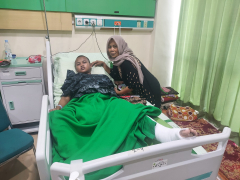Sidoarjo, Indonesia – Sixteen-year-old Muhammad Royhan Firdaus had just finished praying on the first floor of the Al-Khoziny Islamic Boarding School in the East Javan city of Sidoarjo on Monday when something struck him on the head.
When he looked up, he saw pieces of the ceiling falling upon him and the other boys, all aged 12 to 18.
Recommended Stories
list of 3 items
- list 1 of 3Death toll from Indonesia school collapse rises to 36 as search continues
- list 2 of 3How 13-year-old Haikal survived Indonesia’s deadly boarding school collapse
- list 3 of 3Survivors pulled from collapsed school in Indonesia
end of list
“I thought it was an earthquake,” he said. “We all started to run.”
But it wasn’t an earthquake.
For several weeks, construction work had been taking place at the school, where builders were pouring concrete on two upper floors. The weight of the concrete caused the building to collapse in layers that Indonesian officials described as resembling a “pancake”.
Muhammad fell several times as he fled and was hit by debris, including large chunks of crumbling cement. Fuelled by adrenaline, he said he felt “nothing at the time” but once he was outside and had collapsed on the ground, he realised his leg was broken. He had also fractured his shoulder so severely that doctors at Siti Fajar Hospital in Sidoarjo had to insert a metal pin to hold it together.
While more than 100 students managed to flee the building, as of Sunday, the number confirmed killed had risen to 40.
Rescue teams are still trying to recover bodies, with about 27 more students thought to be under the rubble. On Thursday, it was announced that thermal drones had found “no further signs of life”.
‘A tragic accident’
In the aftermath of the deadly incident, questions have been raised about the safety of the structure and why construction work was going on while students were inside.
But neither Muhammad nor his mother, Yuni, had any concerns about him returning to the school, where he had studied since he was 12.
“I am not scared to go back to the school,” Muhammad said as his mother expressed hope that he could continue his studies there once it has been rebuilt.
“We consider this a tragic accident,” Yuni added, explaining that she had no desire to blame school authorities.
All but one of the dozen parents Al Jazeera spoke to said they want their child to return to the school.
Syamsul Arifin, who teaches the sociology of religion at Muhammadiyah University in the nearby city of Malang, explained that Islamic boarding schools like Al-Khoziny play an important role in conservative religious communities, and it is against this backdrop that the reluctance to attribute blame must be understood.
“While parents may be understandably shocked or saddened by the incident, they are unlikely to want to blame the owners or leaders of the school where there is essentially a patron and client relationship,” he said.
These schools offer “a sacred canopy for students that protects and comforts them, which is why their parents submit to the leaders [of the schools] completely,” Arifin added.

‘Religious authority’
Indonesia has more than 30,000 Islamic boarding schools, known as pesantren, where students live in dormitories and study under religious scholars called kyai, or ustadz.
Pesantren focus on religious education, although many, like Al-Khoziny, also teach secular subjects.
In East Java province alone, there are almost 7,000 pesantren.
“Kyai and ustadz are incredibly well respected, particularly in [conservative areas like]





